Orion, the renowned hunter from ancient Greek mythology, is widely recognized for his exceptional skills and accomplishments. He is often depicted as a magnificent giant who possessed the ability to overcome any creature.
Despite being the son of a legendary deity, Orion’s relationship with the gods was far from harmonious. As history has shown, even those favored by fortune eventually fall out of favor, and Orion’s tale serves as a testament to this. Which creature ultimately brought about the downfall of this illustrious hero? And how does their eternal feud continue to play out in our modern world?
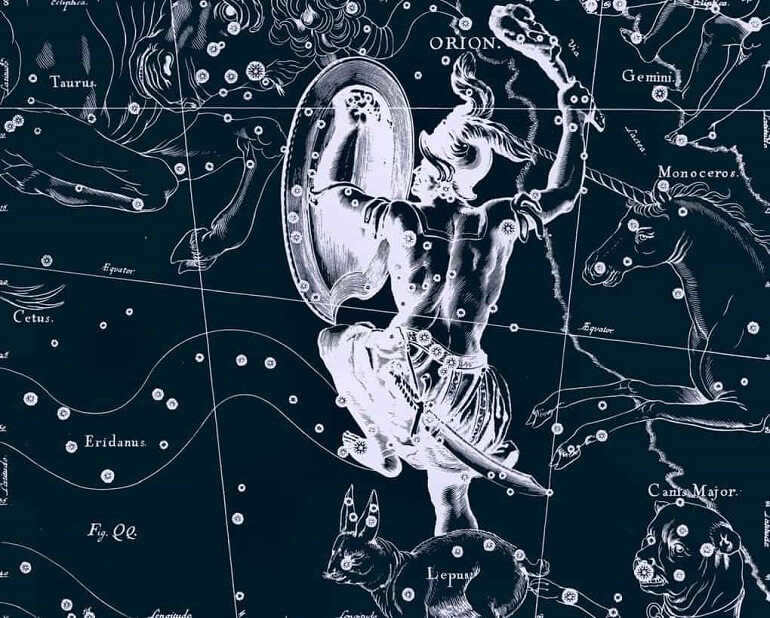
Orion – a product of magic or his mother?
According to Hesiod, Orion was believed to be the son of Poseidon himself, who bestowed upon him extraordinary abilities. As he grew older, Orion not only became a giant and handsome, but also possessed a unique gift that inspired countless legends – the ability to walk on the waves of the sea as if they were solid ground.
A captivating myth recounts the birth of Orion into the world. Once, a trio of gods – Zeus, Hermes, and Poseidon – gathered at the sanctuary in Thebes. At that very moment, an elderly Theban man named Hyrias approached the altar, questioning the deities as to why they had not blessed him with children throughout his lengthy life.
Zeus made the decision to show mercy to the elderly man, and Poseidon instructed Girieus to retrieve the hide of a bull. As soon as the old man completed his task, the gods covered the hide with soil. After the specified time had passed, instead of finding the remains of the bull, Girieus discovered a child in the pit.
It is worth mentioning that not all ancient writers agreed with this theory of Orion’s birth. More commonly, he was said to have been born in a more traditional manner, with his mother being one of the Gorgon sisters or the revered earth goddess, Gaea.
Trials and Resentment
Consequently, the adult Orion couldn’t envision his life without wanderings and thrilling escapades. Feeling the fortitude to conquer obstacles, the protagonist embarked on a journey to the enchanting island of Chios, where, unbeknownst to him, he would encounter his true love. And that love turned out to be none other than the resplendent Princess Merope.
Orion hastened to approach her father, who didn’t exactly welcome the arrival of his prospective son-in-law. The king issued a daunting task to Orion, one that would determine whether he was deserving of his daughter’s hand in marriage.
Orion was commanded to vanquish all the ferocious beasts that plagued the island’s inhabitants. Naturally, we understand that the king’s intention was to eliminate the young man, but Orion embraced the challenge with unwavering confidence and valor. Given his exceptional hunting abilities, he effortlessly obliterated the predators and monsters that roamed the island.
The joyful Orion presented himself before King Oinopion, delivering the news that his realm had now attained a state of tranquility and serenity. However, the ruler feigned disbelief towards the hunter’s proclamation. Filled with rage, Orion resolved that Merope would still remain his possession.
In the evening, he surreptitiously entered the chambers of the maiden and forcefully took her, an act that her father discovered come morning. It appears to me that the king even welcomed this turn of events – now Orion was deemed a criminal. Oinopion commanded that the eyes of the violator be gouged out and he be cast upon the sandy shore.

Orion, the celestial hunter, was romantically involved with two goddesses
After regaining his sight on a deserted island, Orion heard the ethereal voices of divine beings instructing him to “follow the light and you shall see.”
Interpreting the message correctly, Orion awaited the touch of Eos, the goddess of the dawn, and miraculously, his vision was restored. For a considerable period, he became entangled in a passionate affair with Eos, but his desire for revenge against the king remained unquenched.
Driven by an insatiable thirst for vengeance, Orion embarked on a relentless pursuit of Oinopion, the king who had wronged him. The legends depict not only his burning desire for retribution but also the dangerous obsession that threatened to consume Orion’s very soul.
Once again, it was love that came to his rescue. This time, it appeared in the form of Artemis. The stunning huntress felt a deep connection with the man for the very first time, causing him to forget all of his sinister plans.
A brush with mortality
Now, take a moment to imagine this: Orion was blessed with the favor of the gods, and he became the beloved of the most enchanting of all the young goddesses. One can only imagine the overwhelming joy that would come with such a situation.
Feeling invincible, Orion begins to boast about his newfound greatness, surpassing even the dreams of the mighty Thunderer himself. This arrogant behavior infuriates the gods, particularly the powerful Hera. In retaliation, the goddess creates a treacherous creature, the only being capable of bringing about Orion’s downfall.
During another hunting expedition, the protagonist became overly engrossed and accidentally stepped on an inconspicuous scorpion, which swiftly stung him. Witnessing the agony of her beloved, the sorrowful Artemis hurriedly sought out the physician Asclepius, only to be outpaced by Zeus. With a precise lightning strike, Zeus incinerated Orion’s body, leaving no opportunity for his salvation.
Nevertheless, the beloved huntress immortalized Orion’s likeness in the celestial realm – transforming him into one of the most radiant and enigmatic constellations. Upon learning of this, Hera decided to also elevate her scorpion to the stars.
If you possess an interest in astronomy, you may have noticed that the Scorpius constellation appears to be in pursuit of Orion, who perpetually evades him in the nocturnal sky. The mythological drama depicted in ancient tales is still observable in our modern era, on any clear night adorned with stars.

The constellation of Orion is shrouded in numerous enigmas, as it is widely believed to be a potential hub for extraterrestrial intelligence and the existence of beings from other galaxies. The mythical figure after whom the constellation is named was not exactly virtuous. The legends surrounding Orion serve as a reminder that the most formidable foe can often be inconspicuous and seemingly insignificant, possessing a dangerous combination of cunning and agility that rivals the grandeur and might of more imposing adversaries.
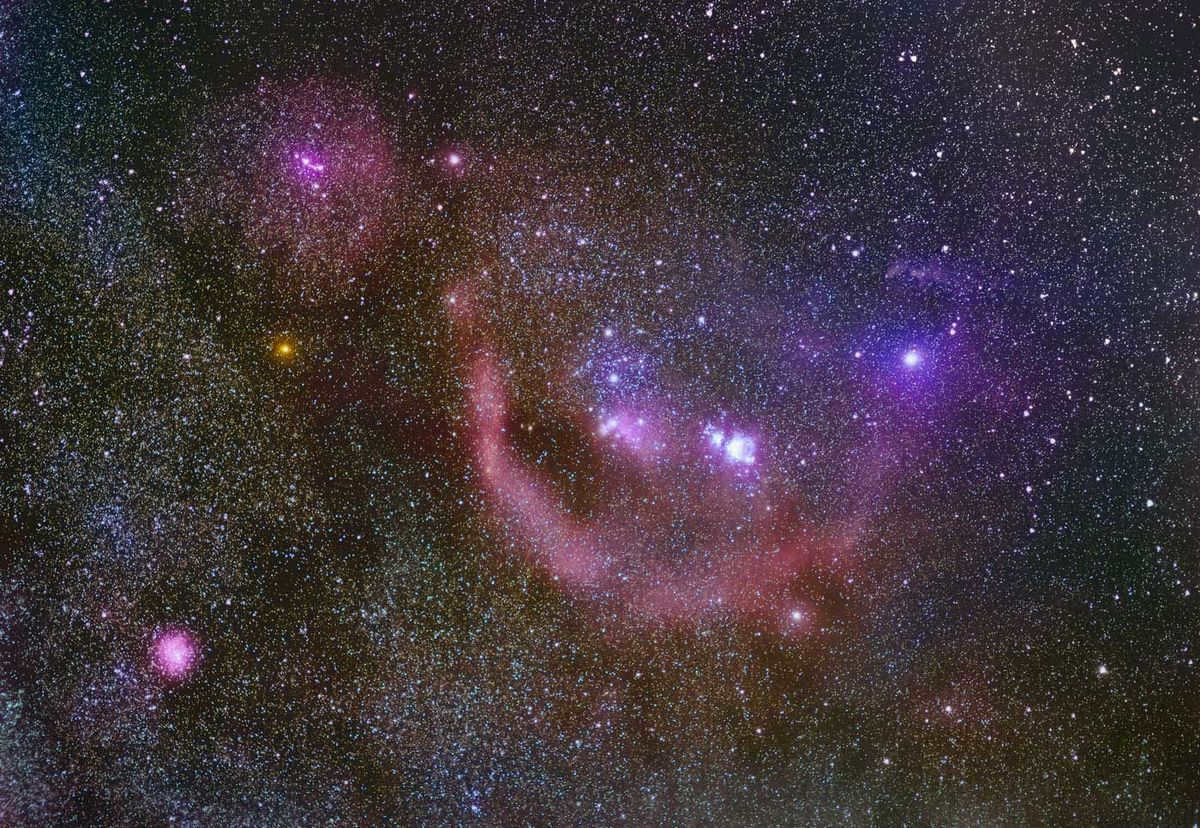
The arrangement of stars that form the constellation Orion can be seen most clearly in the winter night sky in the northern hemisphere. This particular constellation gets its name from Orion, a legendary giant hunter in Greek mythology.
A constellation is essentially a collection of stars that, when observed as a whole, create an imaginary but easily recognizable pattern. This pattern can represent anything from an animal to a mythological deity.
To date, astronomers have identified a total of 88 constellations (officially recognized by the International Astronomical Union in 1922) that can be observed from both the northern and southern hemispheres.
Out of these 88 constellations, only a select few have gained significant popularity not only within the scientific community but also among amateur stargazers. The constellation Orion is undoubtedly one of those well-known constellations.
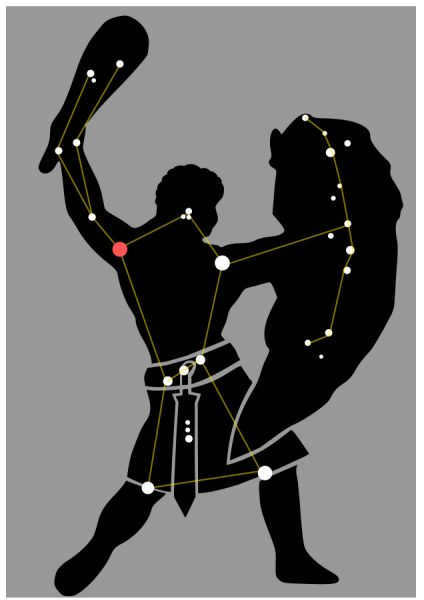
Discovering Orion
Orion is easily identifiable among the stars in the night sky, regardless of whether you are in the northern or southern hemisphere. Positioned along the celestial equator, which is an extension of Earth’s equator into space, Orion offers a captivating sight.
Interestingly, when viewed from the southern hemisphere, the constellation appears upside down and mirrored. This unique perspective adds to the intrigue of Orion’s presence.
The best time to observe Orion is during the winter months, between 85 degrees north latitude and 75 degrees south latitude. So bundle up and enjoy the spectacle!
Characteristics of the constellation
The constellation boasts Rigel (Beta Orionis) as its most luminous star, positioned at the lower left of the Hunter (as observed from the northern hemisphere). To the naked eye, Rigel appears as a solitary star, while in reality, it consists of a quartet of stars. The primary star, Rigel A, is a blue supergiant.
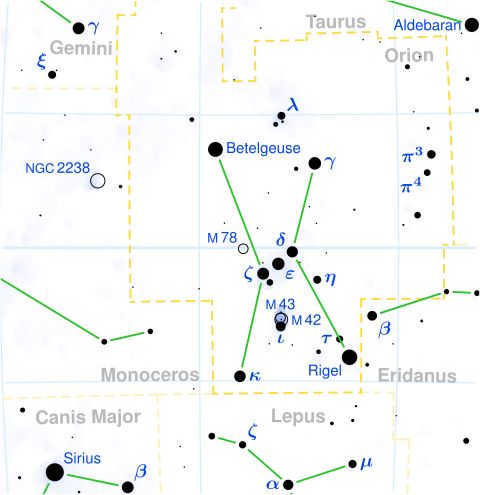
Saif can be found in the lower right area of the Orion constellation. Despite being a supergiant, Saif is smaller and much less bright compared to Rigel.
Betelgeuse (Alpha Orionis) and Bellatrix (Gamma Orionis) serve as the right and left shoulders of the constellation, respectively. The scientific community has recently shown significant interest in the red supergiant, Betelgeuse.
This star exhibits a highly variable apparent magnitude (+0.0 to +1.3), which means it goes through periods of dimming and brightening. Occasionally, Betelgeuse even surpasses Rigel (if only momentarily) to become the brightest star in the constellation. It is one of the largest stars visible in the night sky, estimated to be about a thousand times larger than our Sun.
Orion’s Belt
The constellation Orion is known for its distinctive pattern of stars, including the famous Orion’s Belt. This belt is formed by four stars – Rigel, Saif, Betelgeuse, and Bellatrix – which come together to create a quadrilateral shape in the night sky.
Located at the center of this quadrilateral is the asterism known as Orion’s belt. Comprised of three stars – Alnilam, Alnitak, and Mintaka – this group is particularly well-known and easily recognizable. In fact, these stars are so bright that they are each at least 90,000 times brighter than our own Sun.
When observing the night sky, one can easily spot Orion’s belt as these three stars appear in a straight line. It is a popular target for stargazers and amateur astronomers alike.
Sabre
A little bit below the three bright stars that form Orion’s belt lies a cluster of stars and celestial objects that constitute Orion’s Huntsman’s Sabre. One of the most notable features in this area is the Orion Nebula, alternatively referred to as Messier 42.
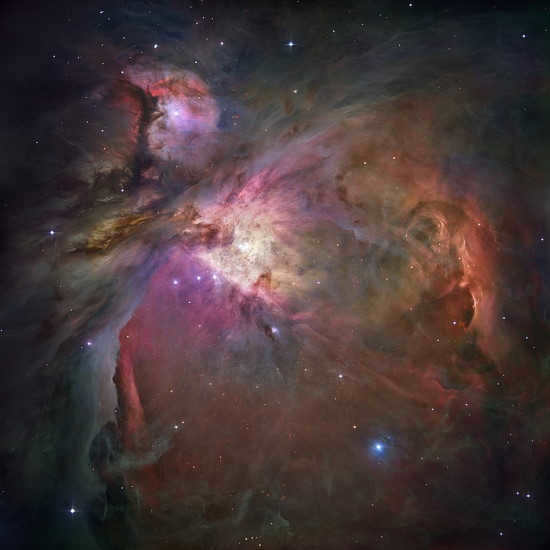
Situated within the confines of the Milky Way, M42 resides at a distance of approximately 1,300 light-years from our solar system and could potentially be the nearest active region where stars are currently forming, commonly referred to as a stellar nursery, in relation to planet Earth.
Contained within the Orion Nebula is the Trapezium, also known as the Trapezium Cluster, which consists of a relatively young group of stars that play a crucial role in illuminating the surrounding area. The stars that can be observed within this region include 42 Orionis and Theta Orionis, which form a multiple star system.
Nevertheless, the most prominent star within the Orion constellation’s belt is Iota Orionis. This particular star is part of a system that comprises at least four stars and is situated approximately 2,300 light-years away from our planet.
The Shield and the Mace
Orion’s arm and mace consist of a chain of five stars situated north of Betelgeuse. These stars include Mu Orionis, which is positioned directly above the red supergiant, as well as Nu and Ci Orionis, and Chi (X1 and X2) Orionis.
Additionally, to the west of Bellatrix, there is a collection of six stars collectively known as Pi Orionis, which form an arch. These stars together symbolize the Shield or Bow of Orion.
Did you know these fascinating facts about the Orion constellation?
The constellation Orion holds the distinction of having the oldest reconstructed star chart known to mankind. Unearthed in a cave in Ach, Germany during archaeological excavations in 1979, an ancient ivory tablet dating back 32,500 years depicted the hunter Orion in intricate carvings.
Orion may harbor exoplanets
Astronomers have long speculated about the possibility of exoplanets existing in the Orion constellation. One star in particular, CVSO 30, located approximately 1,200 light-years away from Earth, is thought to host two massive gas giants named CVSO 30 b and CVSO 30 c.
The planetary system of CVSO 30, if it does indeed exist, is truly one of a kind. The remarkable difference in distance between the two planets and their parent star is a phenomenon that has never before been witnessed. CVSO 30 b completes its orbit around the star in under 11 hours, while CVSO 30 c takes a staggering 27,000 years to do the same.
This information could potentially be utilized for celestial navigation purposes when observing other visible stars.
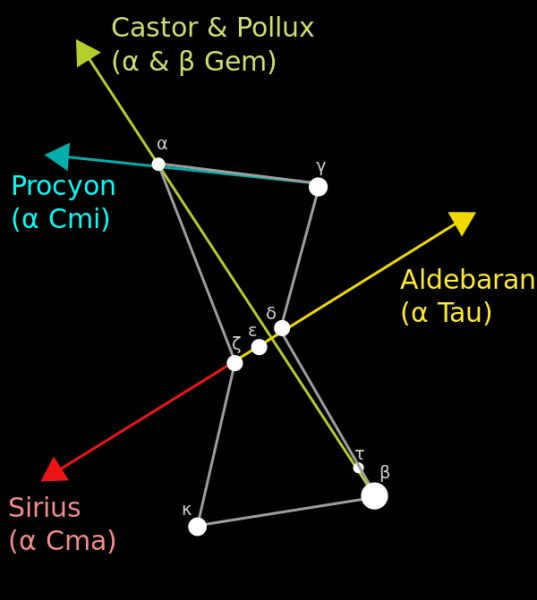
If you continue the line of Orion’s belt to the west (northwest), you will come across the first bright star, Aldebaran. This star is a part of the Taurus constellation and is located approximately 65 light years away from our solar system.
In the exact opposite direction (southeast), you will find Sirius. It is the brightest star in the night sky and is a part of the Canis Major constellation, also known as the Big Dog.
To locate Procyon, the brightest star in the Canis Minor constellation, you can follow an imaginary line from Bellatrix through Betelgeuse and continue eastward. Similarly, if you draw a line from Rigel through Betelgeuse, you will arrive at Pollux, a giant star in the Gemini constellation.
The future of this constellation
By utilizing data obtained from the Gaia and Hipparcos missions, the European Space Agency has created a simulation that provides insight into the future appearance of the constellation for the following 450,000 years.
In the upcoming 100,000 years or thereabouts, Betelgeuse, a red supergiant positioned at the left shoulder of the Hunter constellation, is projected to undergo a supernova event, resulting in its explosion. Additionally, numerous nascent stars will emerge from the molecular cloud enveloping this particular area.
Interesting Information and Misconceptions
5. The Orionids, one of the most well-known meteor showers, seem to come from the direction of the Orion constellation (near Betelgeuse). This meteor shower occurs annually in October.
4. Orion showcases a collection of impressive molecular clouds and nebulae that have captivated observers worldwide. Among these is the Lambda Orionis ring. Situated at the center of the ring is Macea (Lambda Orionis), which represents the head of the Orion Constellation.
3. Beneath the Lambda Orionis ring, there is a semicircular emission nebula called Barnard’s Loop. Both formations are part of the Orion Molecular Cloud Complex.
2. In Greek mythology, Orion and Scorpius are portrayed as bitter adversaries. Legend has it that Orion once made a threatening gesture to exterminate all living creatures on Earth. In response, Artemis (or possibly Gaia) unleashed a scorpion to slay the Hunter.
These two constellations are never visible together in the night sky. While Orion graces the winter sky, Scorpius can only be observed during the summer.
1. According to authors Robert Buval and Graham Hancock, there is a deliberate connection between the placement of the three primary pyramids in the Giza complex and the stars in Orion’s Belt. This theory, known as the Orion correlation theory, remains highly debated.
The Orion and Sirius duo represents two celestial entities commonly found in the universe, with the former symbolizing a constellation and the latter representing a star.
- 1 Sirian Orion
- 2 Orion constellation Sirius
- 2.1 Stars of the Orion constellation
- 2.1.1 1. Alnitak
- 2.1.2 2. Alnilam
- 2.1.3 3. Mintaka
- 2.1.4 Horsehead Galaxy
- 2.1.5 Flame Galaxy
- 2.2.1 The Sirius System
- 2.2.2 Parts of Sirius
- 2.2.3 Sirius A
- 2.2.4 Sirius B
Sirius Orion
There are several descriptions that can be attributed to the constellation Orion and its brightest star, Sirius.
Sirius in Orion’s constellation
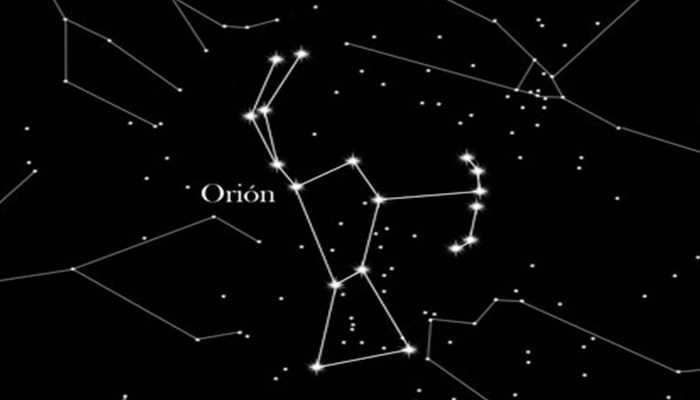
The Orion constellation is likely the most extensively studied in the sky by people all over the world. It can be observed in both hemispheres and contains exceptionally bright stars. Its shape resembles an hourglass, flanked by two prominent stars, Betelgeuse and Bellatrix, and supported by two magnificent worlds, Rigel and Cyphus.
In the center of this area, three other brilliant stars can be found, seemingly following a parallel path. Their names, from left to right, are Alnitak, Alnilam, and Mintaka. The Orion constellation symbolizes a warrior raising his bow, sword, or staff, while shielding himself from the enemy with his skin or shield. Accompanying him are his hunting dogs.
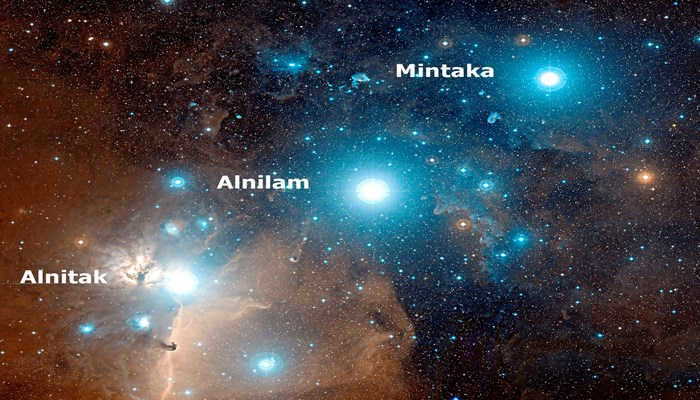
There are stars in the Orion Sirius constellation:
1. Alnitak
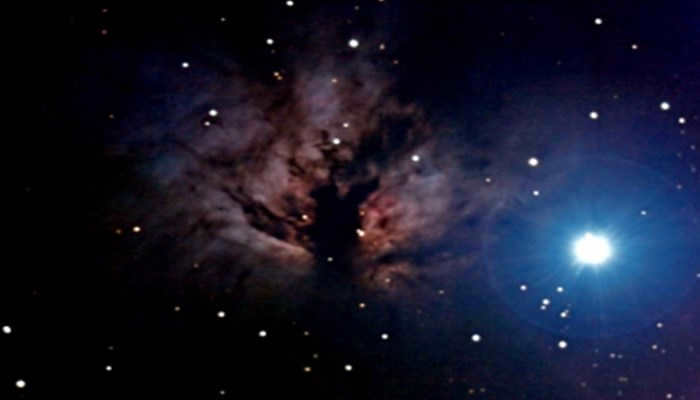
This star’s nickname is derived from Arabic and represents the “belt”. However, originally believed to be approximately 1,500 light-years away from the Solar System, its parallax location determined by the companion Hipparcos resulted in a revised distance of only around 800 light years.
Alnitak is a triple stellar system, with the primary components spaced 2.1 arc seconds apart. The primary star of the Alnitak A system itself consists of a binary star. The prominent component, Alnitak Aa, is a blue supergiant. Alnitak Ab, on the other hand, is an O-type star, but from the main sequence. Alnitak B is also a massive star that orbits the inner pair once every 1,500 years.
2. Alnilam
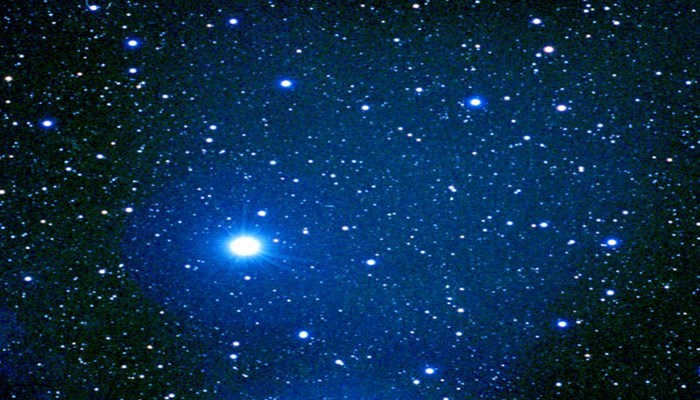
The moniker of this star also originates from Arabic and signifies “string of pearls”. Alnilam is a super blue giant composed of approximately 40 solar clusters, remarkably luminous: housing a vast quantity of ultraviolet radiation emitted by a star. Its luminosity is 375,000 times that of the sun.
With a surface temperature of 25,000 K, it is extremely hot, causing the NGC 2000 nebula to glow. A powerful cosmic wind, blowing from its vicinity at a speed of 20,000 km/s, causes it to coalesce rhythmically. This is 20 million times higher than that of the Sun.
3. Mintaka.
Mintaka is the third star in Orion’s Belt. It is a triple star system located approximately 1,200 light-years away from Earth. The primary star, Mintaka A, is a blue giant with a surface temperature of about 31,500 Kelvin. It is about 20 times more massive than the Sun and shines about 90,000 times brighter. Mintaka B is a blue-white star that is about 3.2 times more massive than the Sun. Mintaka C is a fainter star located further away from the primary star. Overall, Mintaka is an interesting and visually striking star system in the constellation of Orion.
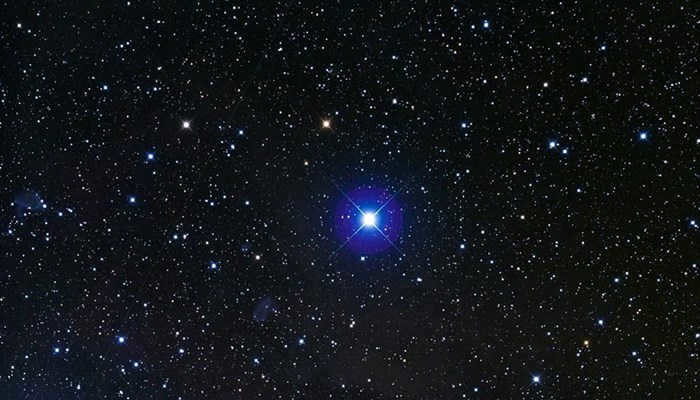
The nickname he goes by also represents a belt in Arabic. In reality, Mintaka is actually a complex composite star; situated just one minute of arc away from a significant star, it is in the line of fire of a star with an estimated magnitude of 6.8. After being observed for 915 years, there is a minimum time difference of 0.25 years between the two. In the space between these two entities lies a faint star with a size of 14. The star with a magnitude of 6.8 is a component of a binary spectroscopic star system.
The primary component we mention, Mintaka, possesses a stellar magnitude of +2.23 and functions as a star in a similar manner. Both components, which have also been examined through spectroscopy, display bending. The orbital phase of this binary system lasts for 5.73 days, causing a slight mutual obscuration and resulting in a luminosity variation of 0.2 magnitudes.
Among the notable celestial objects located in the Belt are the Flame Galaxy and the Horsehead Galaxy.
Horsehead Galaxy
The Horsehead Galaxy is a frigid obsidian cloud situated approximately 1,500 light-years away from Earth, to the southern region of Orion’s Belt. It forms a component of the perplexing molecular clouds of Orion, spanning a width of roughly 3.5 light-years. This enigmatic galaxy presents itself in opposition, emerging from the forefront of the striking IC 434 galaxy. Based on its captivating visual representation, it stands as the most renowned among the enshrouded galaxies.
Flame Galaxy
He adopts the name Flame Galaxy due to his unique appearance. The hydrogen atoms in Galaxia are consistently ionized by the brightness of nearby Alnitak, which emits powerful ultraviolet radiation that causes the atoms to release their elements. The majority of the galaxy’s luminosity is produced when these elements combine with the ionized hydrogen, resulting in the emission of a reddish light.
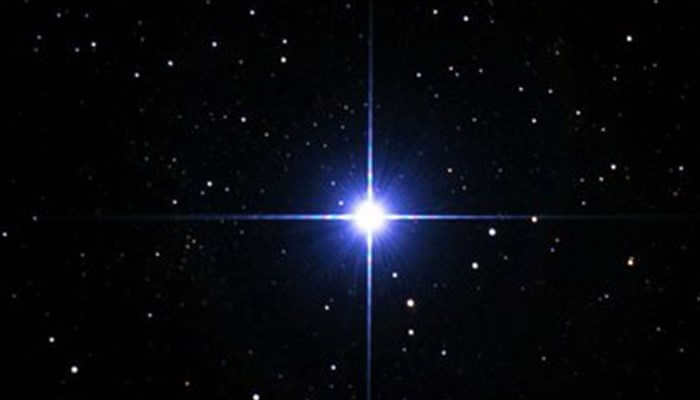
Sirius, also known as the alpha star Canis Majoris, is the brightest star visible from Earth at night. It is situated in the southern hemisphere region of the Canis Major constellation. This significant star, which consists of two elements, has been well-known since ancient times.
Due to certain irregularities in the Sirius system caused by the presence of the two stars, there is speculation about the existence of another star called Sirius C. This hypothetical red dwarf is believed to have one-fifth of the mass of our Sun and falls under the spectral class M5-9. It is said to orbit around Sirius A every six years. However, the existence of Sirius C is still a subject of debate and has not been confirmed.
The Sirius system
is a well-known star system in the sky. It is located in the Canis Major constellation and is one of the brightest stars visible from Earth. The Sirius system consists of two stars, Sirius A and Sirius B, with Sirius A being the larger and brighter of the two. This binary star system has been studied extensively by astronomers and has provided valuable insights into stellar evolution and the dynamics of binary star systems. The Sirius system is also of cultural significance, as it has been recognized and revered by various civilizations throughout history.
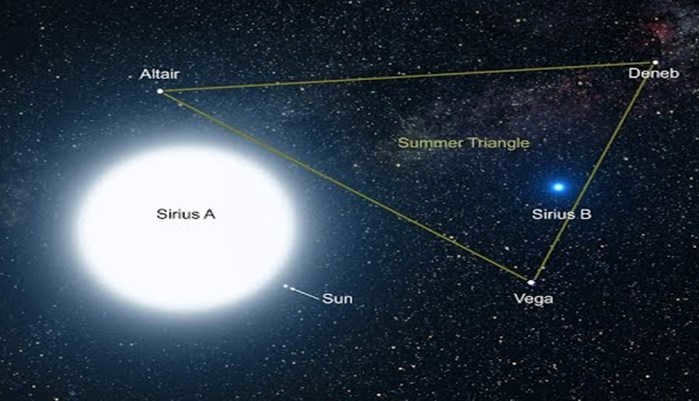
Sirius is a binary star system comprised of two white stars that orbit each other at a distance of approximately 20 astronomical units, which is roughly the distance between the Sun and Uranus. The orbital period of the system is around fifty years, and its age is estimated to be around 230 million years. It is believed that Sirius used to be two bluish morning stars, each following an elliptical path with a period of 9.1 years.
Components of Sirius
Sirius A
Sirius A possesses a mass that is approximately 2.02 times the mass of Star King 5, which amounts to 59.62 kg. Sirius A’s channel was concealed via a celestial interferometer. Its rotational velocity is relatively moderate, at 1030 km/s, as it does not result in a noticeable bulging of the disk, contrary to the behavior exhibited by the giant-like star.
Sirius B is the nearest white dwarf to us. Planet. It has a mass typically equal to that of our Sun, making it one of the most massive white dwarfs that are in the spotlight, since on average they have half the mass of the Sun, and on top of that, with the same density as the Sun, its size is larger than that of the Earth, so its gravitational pull is remarkable.
A white dwarf of this kind is formed only after a star has evolved from its original sequence and gone through the red giant phase. In the case of Sirius B, this happened when the star reached the middle of its current age about 120 million years ago.
During the main series, the original star of class B had an estimated mass of around 5 M☉. This article reveals interesting information about the Syrian Orion.
This article adheres to our editorial ethics guidelines. If you find any errors, please click here to report them.
Full article path: postpost “Galaxies” What are the constellations of Orion and Sirius?
Here is a comprehensive overview of what is currently known about the Orion constellation, which is the most prominent and easily recognizable constellation visible from Earth. Orion contains some of the brightest stars in the night sky and is home to the largest stellar nurseries.
Advertisement
In 1979, archaeologists made an incredible discovery in the Ach Valley of Germany. They found a small ivory tablet that is estimated to be between 32,500 and 38,000 years old. What makes this tablet so fascinating is the carved image it contains. The image depicts a humanoid figure with arms and legs outstretched, resembling the stars of the famous constellation Orion.
Many experts believe that this tablet is actually the world’s oldest star chart. It suggests that even thousands of years ago, people had a deep understanding of the night sky and the constellations within it. The constellation Orion is particularly significant, as it is located on the celestial equator and contains some of the brightest stars in the sky. In fact, recent discoveries have revealed that at least 10 of these stars are surrounded by exoplanets.
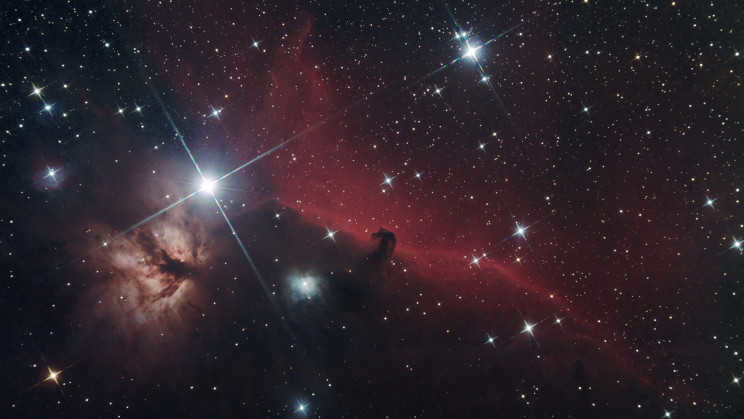
The Horsehead and Flame nebulae can be seen in the Orion constellation.
advertisement
Orion is easily visible from Earth and is home to some of the most brilliant stars in the night sky, including Rigel and Betelgeuse.
Orion is the 26th largest constellation and contains seven prominent stars, along with numerous other celestial objects. The distance between Earth and Orion ranges from 243 to 1360 light years. The closest star, Bellatrix, is approximately 244 light-years away, while the farthest star, Alnilam, is located 1,344 light-years away.
The constellation is named after the hunter Orion, a figure from Greek mythology, which is why it is also known as the hunter’s constellation.
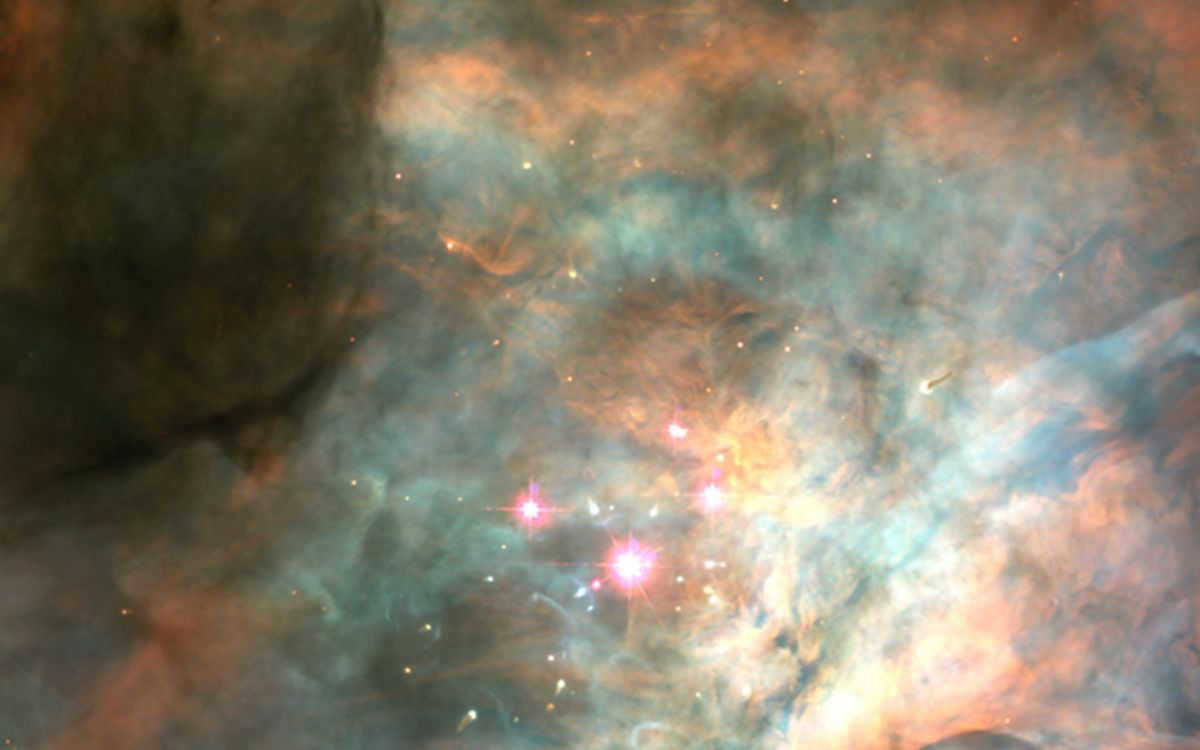
A trapezoid located in the Orion constellation. Credit: C.R. O’Dell and S.K. Wong (Rice University) and NASA/ESA
Where can you find the Orion constellation?
advertisement
The Orion constellation can be found in the southwestern part of the sky in the Northern Hemisphere, or in the northwestern part if you are in the Southern Hemisphere. It is most visible at latitudes between 85° and -75°, with a right ascension of five hours and a declination of five degrees. Orion is one of the 15 stellar configurations that cross the celestial equator. Covering an area of approximately 594 square degrees, it is bordered by the Monocerus, Taurus, Lepus, Gemini, and Eridanus constellations.
In 1930, the limits of Orion (as well as the rest of the constellations) were established by Eugène Joseph Delporte, a renowned astronomer from Belgium. The Orion constellation is conveniently visible during the day from May to July, whereas the ideal time for observing it at night is between November and February.
Messier’s Discoveries in the Orion Constellation
During his search for comets in the late 1700s, French astronomer Charles Messier stumbled upon a variety of other celestial phenomena. These discoveries diverted his attention from comets, prompting him to create a separate catalog to differentiate them. Messier collaborated with his friend and colleague Pierre François Messier to compile this catalog, which started in 1764.
The initial catalog included 41 entries, and the final version, published in 1781, featured a total of 103 completed entries. These astronomical objects were subsequently named Messier objects. Notably, there are three such objects within the Orion constellation: Messier 78 (Reflection Nebula), Messier 43 (Nebula de Mayrand), and Messier 42 (Orion Nebula).
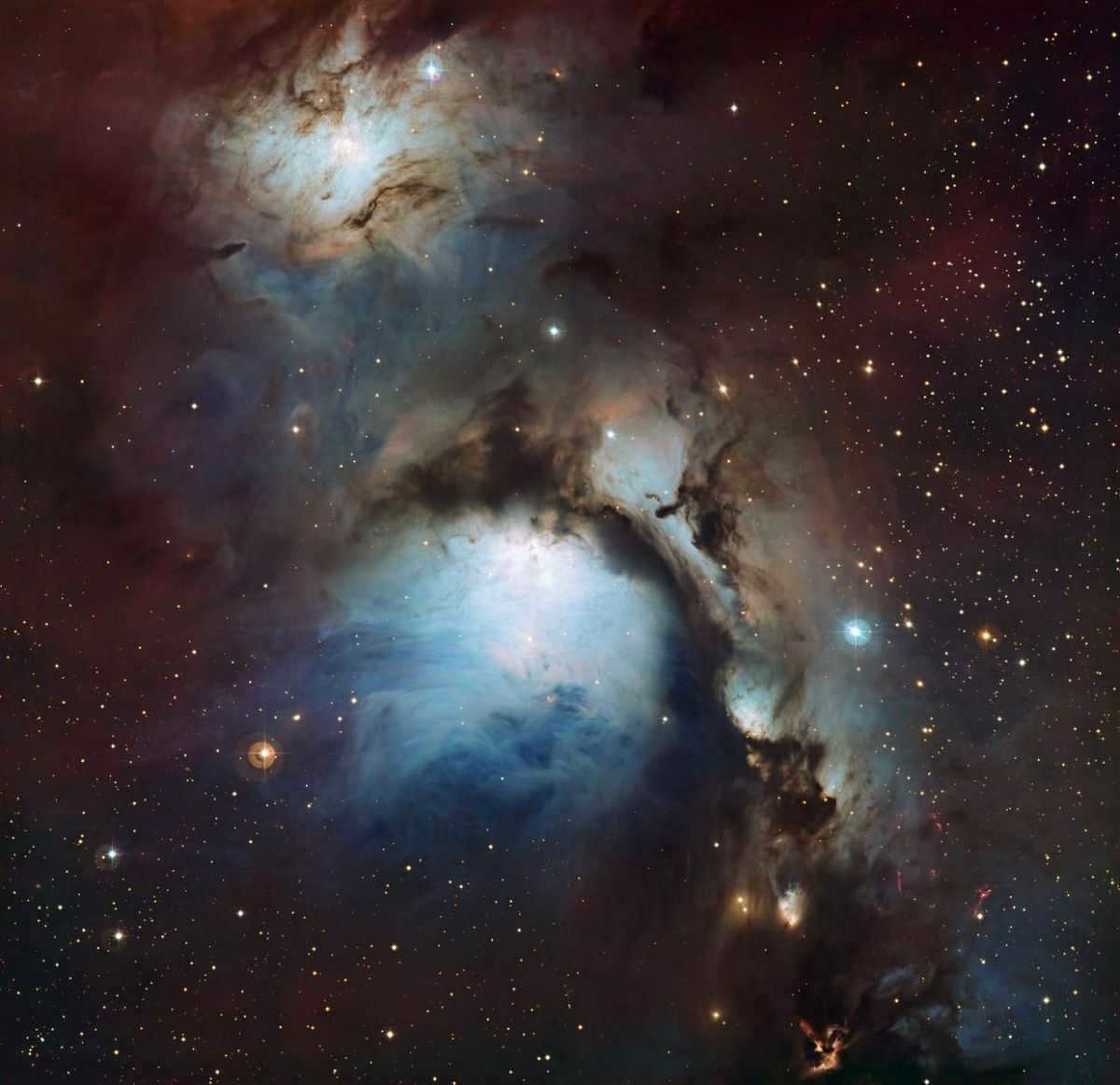
Messier 78. Source: Igor Chekalin/ESO
advertisement
Pierre Messier made a remarkable discovery in 1780 when he found a reflecting nebula in the Orion constellation. This nebula, which spans a diameter of 10 light-years, is located approximately 1,600 light-years away from our planet. It is home to numerous T Tauri stars, believed to have formed within the past 10 million years. Despite their brightness, these stars have not yet reached the stage where nuclear fusion reactions can occur in their cores. It will take tens of millions of years for them to fully mature and achieve their full potential as stars.
Messier 42
is a well-known astronomical object that is also commonly referred to as the Orion Nebula. It is located in the constellation of Orion and is one of the most easily visible and recognizable nebulae in the night sky. Messier 42 is a stellar nursery, meaning that it is a region where new stars are actively forming. It is estimated to be approximately 24 light-years across and is about 1,300 light-years away from Earth. The nebula is illuminated by a cluster of young, hot stars known as the Trapezium Cluster. These stars are so bright that they cause the surrounding gas and dust to glow. Messier 42 is a popular target for amateur astronomers and is often imaged using telescopes and cameras.
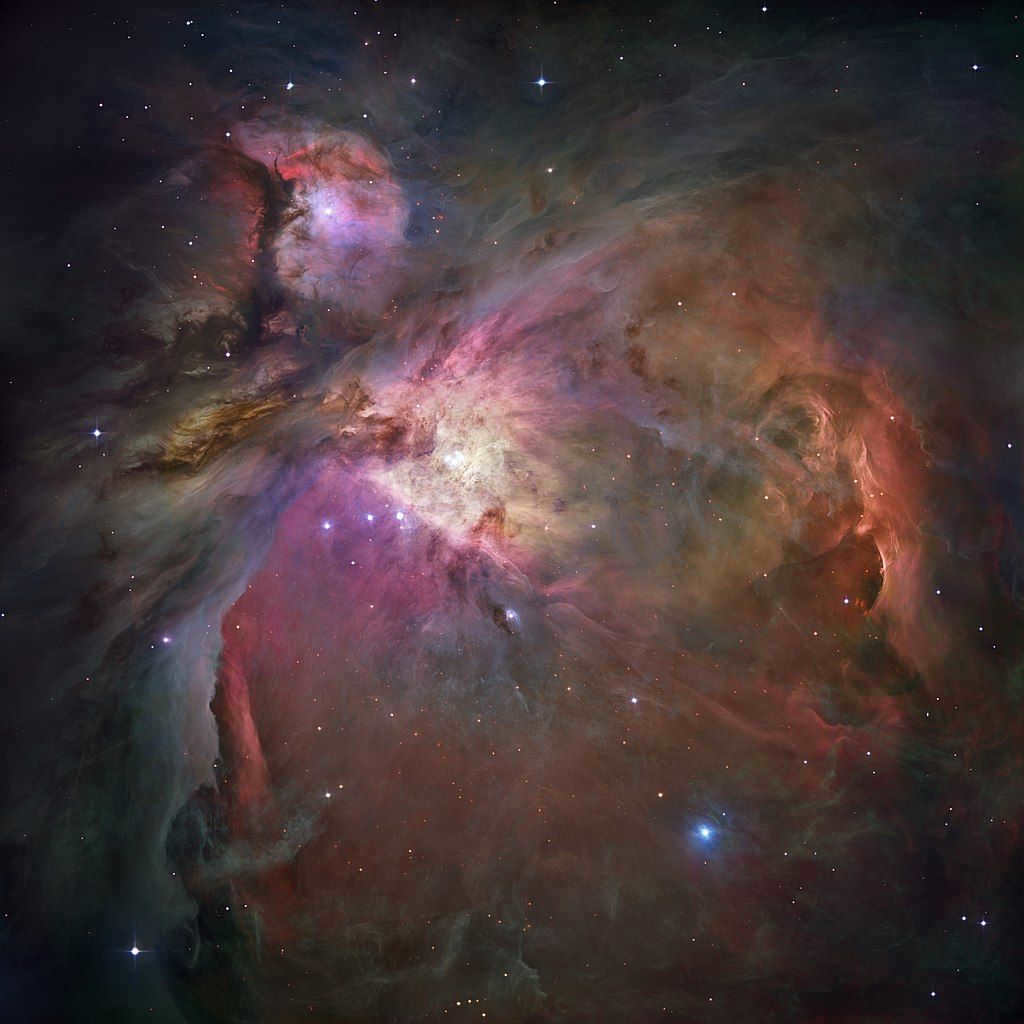
The Orion Nebula, also known as Messier 42, is a large emission and reflection nebula located in the constellation Orion. It is a star-forming region and is situated about 1,344 light-years away from Earth, making it the closest star-forming region to our planet. The Orion Nebula is part of a larger nebula called the Orion Molecular Cloud Complex. Within the Orion Nebula, there is a young star cluster that is dominated by a group of four giant stars known as Trapezium. These stars are arranged in a trapezoidal shape and emit ultraviolet light, which may be preventing the formation of smaller stars in the vicinity.
advertisement
Also known as the Orion Nebula, Messier 42 (M42) is about 1,344 light-years from Earth and is the closest star-forming region to our planet. It is part of a much larger nebula known as the Orion Molecular Cloud Complex. Near the center of M42 is a young star cluster dominated by a group of four giant stars called Trapezium, (because they are arranged in a trapezoidal shape). The ultraviolet light emitted by these stars may be preventing hundreds of smaller stars nearby from forming.
Orionis C, located in the Trapezium, is the most massive member with a magnitude of 5.13. Its surface temperature is estimated to be around 44,726.85°C (45,000 Kelvin), which is more than seven times hotter than the Sun.
Messier 43
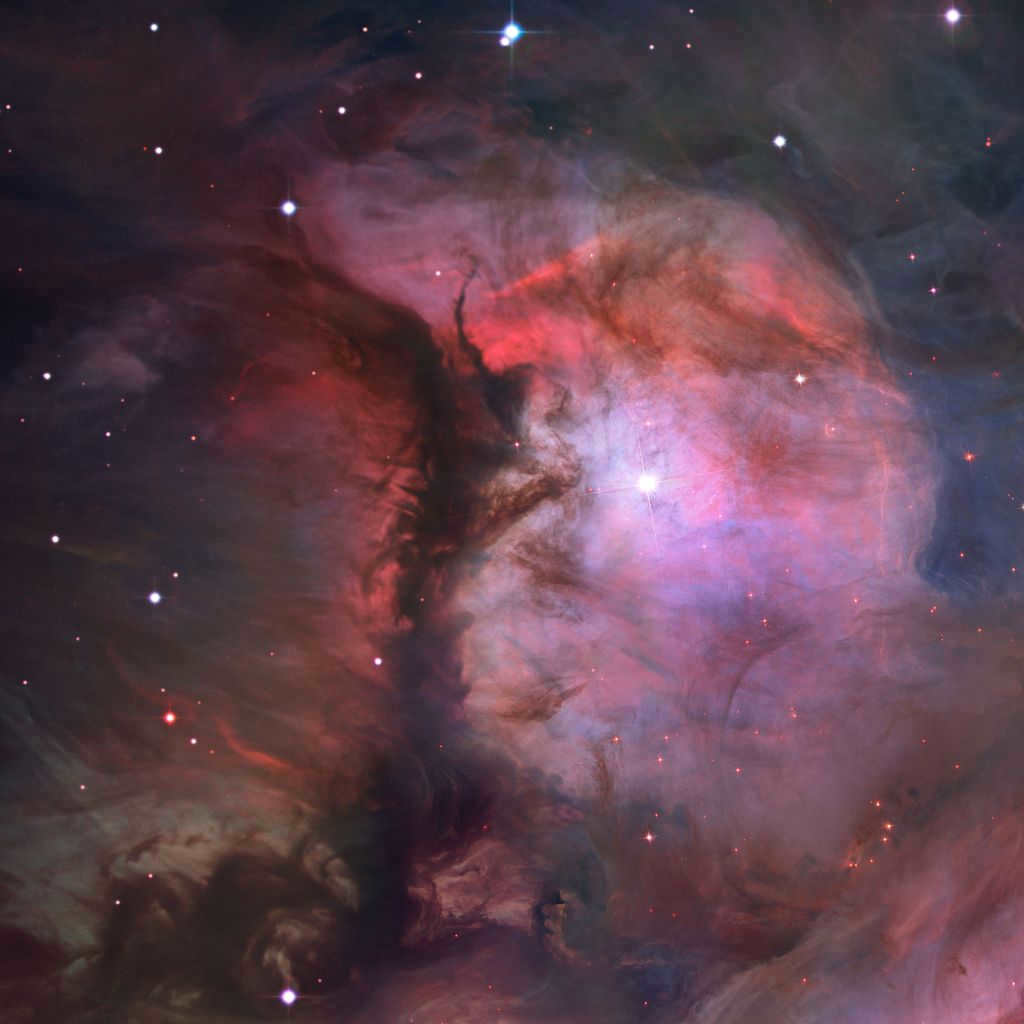
The De Meran Nebula, also known as Messier 43, is an emission nebula located in the constellation of Orion.
Messier 43, or the De Mairana Nebula, can be distinguished from the Orion Nebula by a dense band of cosmic dust. It was first discovered by French astronomer Jean-Jacques d’Ortus de Meyrand in 1731 as a separate nebula from the Orion Nebula. This nebula is formed by a single star. Both nebulae are part of the Orion Molecular Cloud Complex, a massive stellar nursery that includes the Horsehead Nebula (Barnard 33) and the Flame Nebula (NGC 2024). The distance between M43 and Earth is approximately 1,600 light-years, and according to NASA, January is the optimal time for observing this Messier object.
Fascinating information about the star pattern of Orion
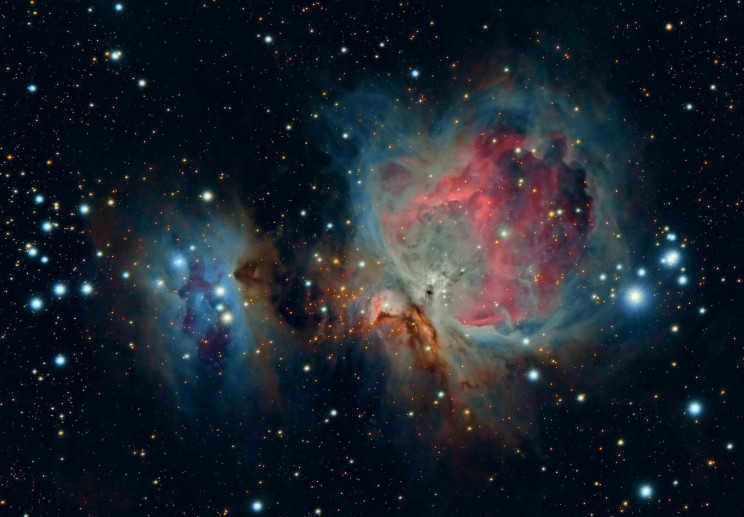
Source: Guillermo Ferla/Unsplash
Here are some fascinating details that further illustrate the importance of the constellation Orion:
Interestingly, the ventilation shafts of two large pyramids in Mexico, which are thought to have been constructed around the 2nd century B.C., and three pyramids on the Giza Plateau might be aligned with stars in Orion’s belt. The ancient Egyptians connected the stars in Orion with Osiris, the deity of rebirth and the afterlife, and believed that the gods were descended from the three stars in Orion’s belt.
The International Astronomical Union has so far named 10 stars in the constellation of Orion. Out of these, nine stars have colors ranging from blue to yellow, or a combination of both. However, there is one star known as Betelgeuse that stands out from the rest due to its vibrant red color and its immense size as a red giant. This star is easily distinguishable from other stars in Orion, even to the naked eye. Betelgeuse is also recognized as the tenth brightest star in the night sky. Its brightness is comparable to that of Ahernar, but it is given the tenth position due to its variable magnitude.
While Orion may be known as a Greek hunter in mythology, it is fascinating to note that this constellation is referenced by various cultures and holds multiple names. For instance, in Norse mythology, the belt of Orion is referred to as Friggerock, which translates to “Frigg’s distaff.” The term “distaff” pertains to a part of a spinning wheel, and this name signifies the spinning wheel that belonged to the goddess Frigg. Interestingly, the sword hanging from the belt was considered a spindle. Moving to ancient Indian Vedas, Orion is depicted as a representation of the deity Shiva. On the other hand, the Lakota people have their own name for this constellation, calling it Tayamnikanhu and envisioning it as the buffalo’s spine. Lastly, in Spanish tradition, the three stars forming Orion’s belt (Alnilam, Mintaca, and Alnitaca) are referred to as “Las tres Marías” or “The Three Marys.”
The annual Orionid meteor shower, which occurs every October, is associated with the constellation of Orion. It is caused by fragments that are created when the Earth crosses the orbit of Halley’s Comet. The Orionids appear to originate from the direction of the constellation Orion, giving them their name.
Rigel, also known as Beta Orion, is the brightest star in the constellation of Orion that can be seen with the naked eye. It is currently the seventh brightest star in the sky. Rigel is a blue supergiant located approximately 864 light-years away from our solar system. It is estimated to have a luminosity between 61,500 and 363,000 times that of our Sun.
Orion is among the 15 constellations situated along the equator, making it visible from every part of the world. This constellation, being the 26th largest, is easily recognizable in the night sky. Covering an area of 594 square degrees, Orion is most visible during the winter months from late November to February. Its history dates back to the 2nd century when it was discovered by the Egyptian mathematician Ptolemy in Alexandria, which was under Roman rule at the time. Ptolemy included Orion in the list of 48 constellations that existed during that period.
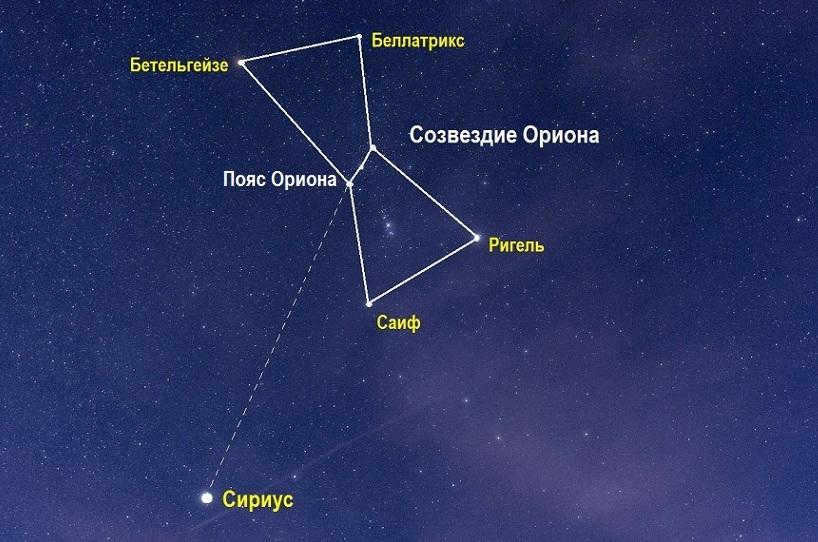
The constellation known as Orion is comprised of two of the most luminous stars in the night sky, Betelgeuse and Rigel. Additionally, this constellation is home to various nebulae, including Orion, De Meran, Horsehead, and many others. Further information regarding these celestial phenomena will be presented in subsequent sections of this article.
Discovering the Orion Constellation
To locate the Orion constellation, one should look towards the first quadrant of the northern hemisphere (NQ1) and observe within a latitude range of +85° to -75°. This stellar formation shares its borders with neighboring constellations such as Gemini, Taurus, Eridanus, Hare, and Unicorn.
Asterisms
The constellation Orion contains a variety of asterisms.
- Cluster (also known as Butterfly). It is composed of six stars: Betelgeuse, Alnitak, Rigel, Mintaka, Saif, and Bellatrix.
- Orion’s Belt is a well-known asterism. It has been utilized as a navigational tool since ancient times. The asterism is called so because it visually forms a belt around the constellation (similar to a belt around a hunter’s attire). It is formed by the following stars (from west to east): Mintaka, Alnilam, Alnitak. The names of the first and last star mean “belt” in Arabic, while the name of the central star means “string of pearls”.
- The asterism called Orion’s Shield is made up of six stars arranged in an arc-shaped pattern (π1, π2, π3, π4, π5, and π6).
- Orion’s Cudgel is located in the northern part of the constellation Orion and consists of five stars: χ2, χ1, ν, ξ, and 69.
Orion is the constellation that gives rise to two meteor showers. Both meteor showers are linked to the remnants of Halley’s Comet in the form of dust and debris. The Orionids meteor shower can be observed annually between October 2 and November 7. On average, about 5 meteorites can be seen per hour during this meteor shower, with the peak occurring on October 21. During the peak, approximately 20 meteorites per hour can be observed.
The primary celestial bodies of the Orion constellation
The most prominent celestial bodies in the Orion constellation consist of Rigel, Betelgeuse, and Bellatrix. These celestial bodies can be easily observed without the aid of a telescope. The diagram of the Orion constellation provides a detailed depiction of each of these stars. Rigel, being the most luminous, takes the leading position among the stars in Orion, while Betelgeuse and Bellatrix follow closely behind. Each of these stars, along with the other bodies within the Orion constellation, will be thoroughly described below, including their distinctive features and precise positions.
Rigel
In Arabic, the name “Rigel” translates to “left foot” due to its position as the left “leg” of the system. This particular star is visible from Earth and has an estimated apparent magnitude of +0.18. Rigel is located approximately 772 light years away from our planet. It is classified as a blue supergiant and possesses a mass that is 2 million times greater than that of the Sun. Additionally, Rigel is a prominent member of the Winter Circle, which is a seasonal asterism.
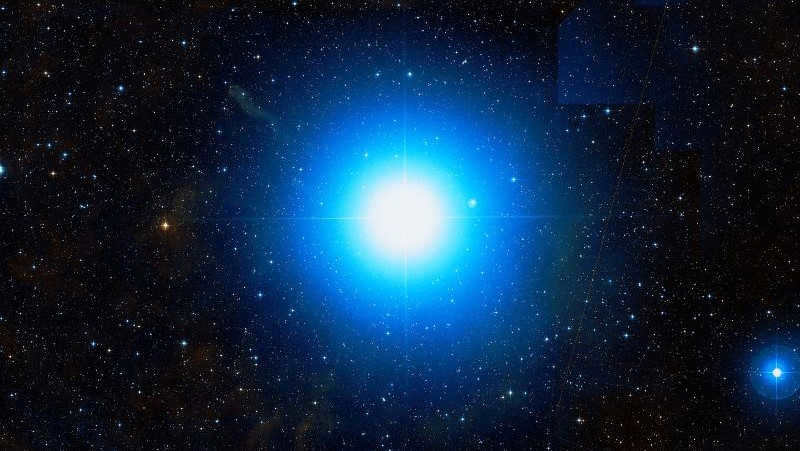
Rigel
Translated from a corrupted form of Latin Arabic as “the pit of Orion” (Beit al-Jawza, where “Jawza” became one of the Arabic names for Orion’s hunter). It forms the right “shoulder.” Rigel is one of the ten brightest stars visible from Earth, with an approximate apparent magnitude of +0.42. This star is located approximately 624 light-years away from our planet. Rigel, a red supergiant, is also included in the list of the largest stellar objects that can be observed with the naked eye. If Rigel were at the center of the solar system instead of the Sun, it would engulf Earth, Mercury, Venus, and Mars.
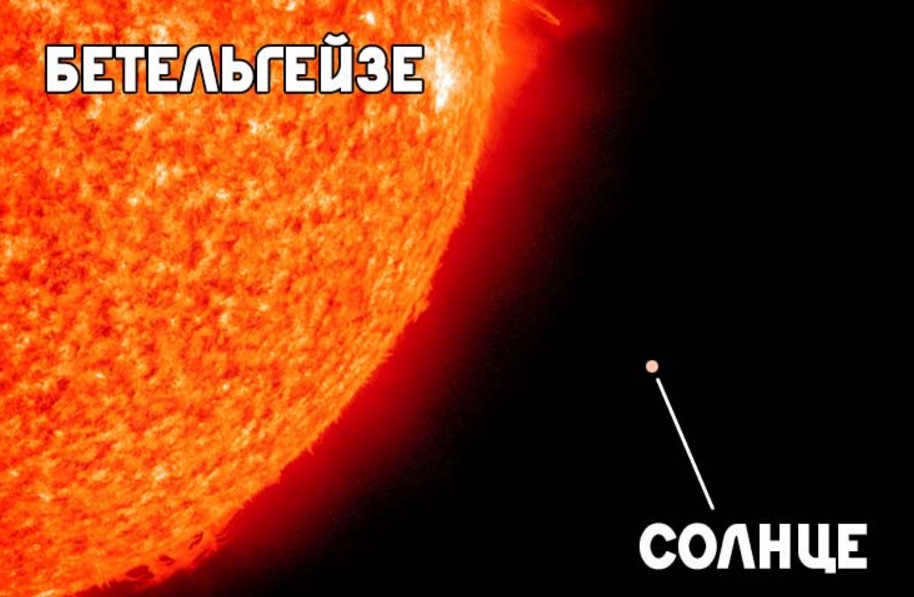
Bellatrix
Translated from Latin as “female warrior,” Bellatrix is the 26th most brilliant star that can be seen from Earth. Its approximate apparent magnitude is +1.64. This star is located within a distance of 245 light-years from our solar system. Bellatrix is 800 times larger than the Sun and it forms the left “shoulder” of the Orion constellation.
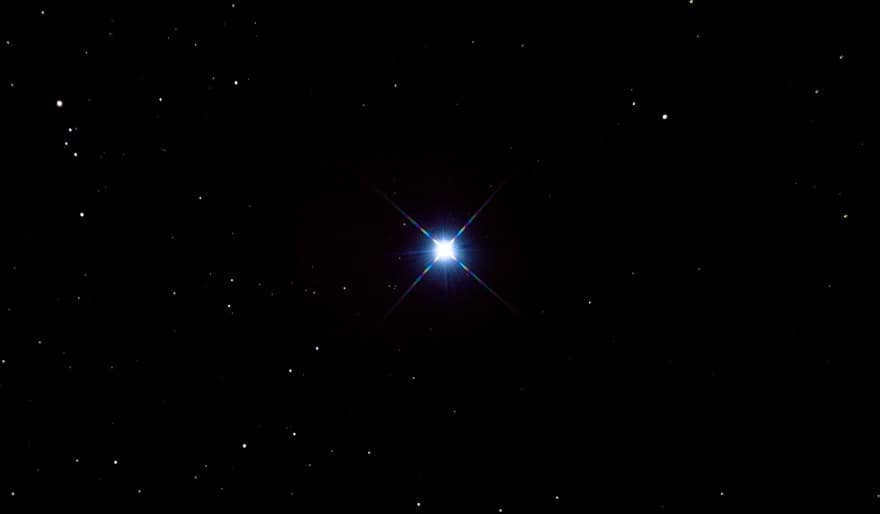
Mintaka
Translated from Arabic, Mintaka means “belt.” It is the 67th brightest star visible from Earth, with an approximate apparent magnitude of +2.2. Located 916 light-years away, Mintaka is part of a system centered around a massive giant star, which has a mass 19000 times greater than that of the Sun. Mintaka is situated alongside Alnilam and Alnitak, forming the iconic Orion Belt. The arrangement of these stars resembles a pointer, pointing southeast towards the brightest star in the sky, Sirius. Mintaka represents the end of the belt and its left “thigh.”
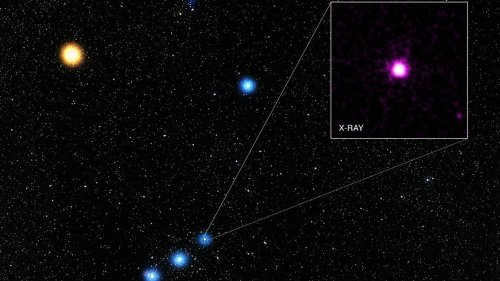
Alnilam
Alnilam, the 29th star that can be seen from Earth, derives its name from the Arabic word for “chain.” With a visible magnitude of +1.69, it is positioned 1,342 light years away from our planet. Notably, Alnilam is a massive star, measuring 140,000 times larger than the Sun. It is also worth mentioning that Alnilam, along with Alnitak and Mintaka, constitutes the famous Belt formation.
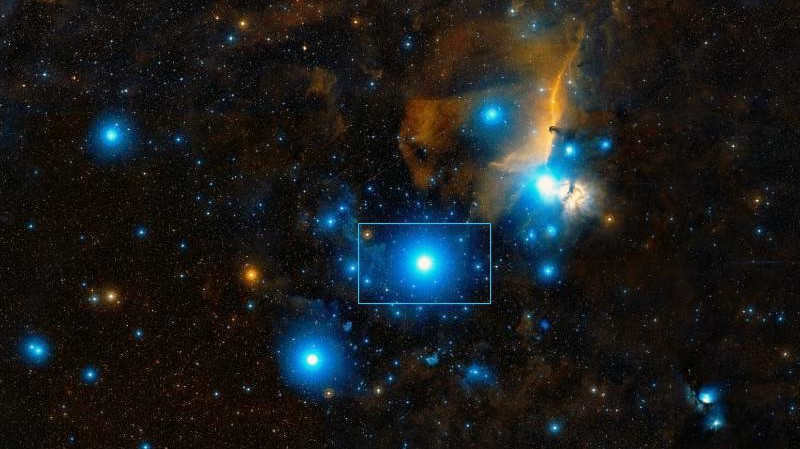
Alnitak
Alnitak, which means “belt” in Arabic, is the 33rd star visible from Earth. It has an approximate apparent magnitude of +1.88 and is located 800 light years away from our planet. This star is part of a three-star system and has a blue supergiant at its core, which is 33,000 times more massive than the sun. Together with Alnilam and Mintaka, Alnitak forms Orion’s belt.
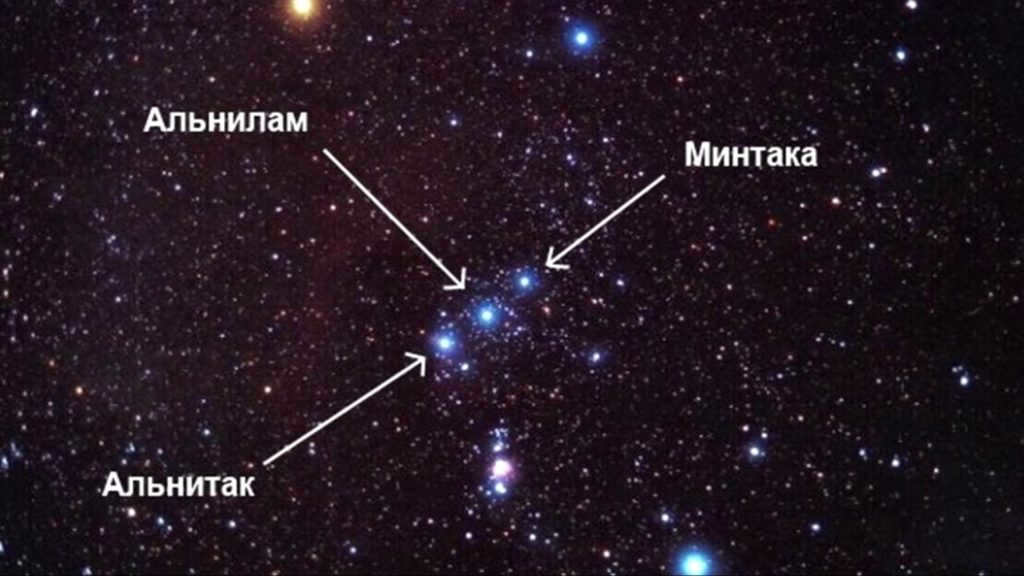
Saif
Also known as “sword,” Saif is the 59th star that can be seen from Earth. It has an estimated apparent magnitude of +2.07 and is located approximately 650 light years away from our planet. Saif is an enormous star, measuring 45,000 times larger than the Sun. It can be found forming the right foot of the constellation Orion.
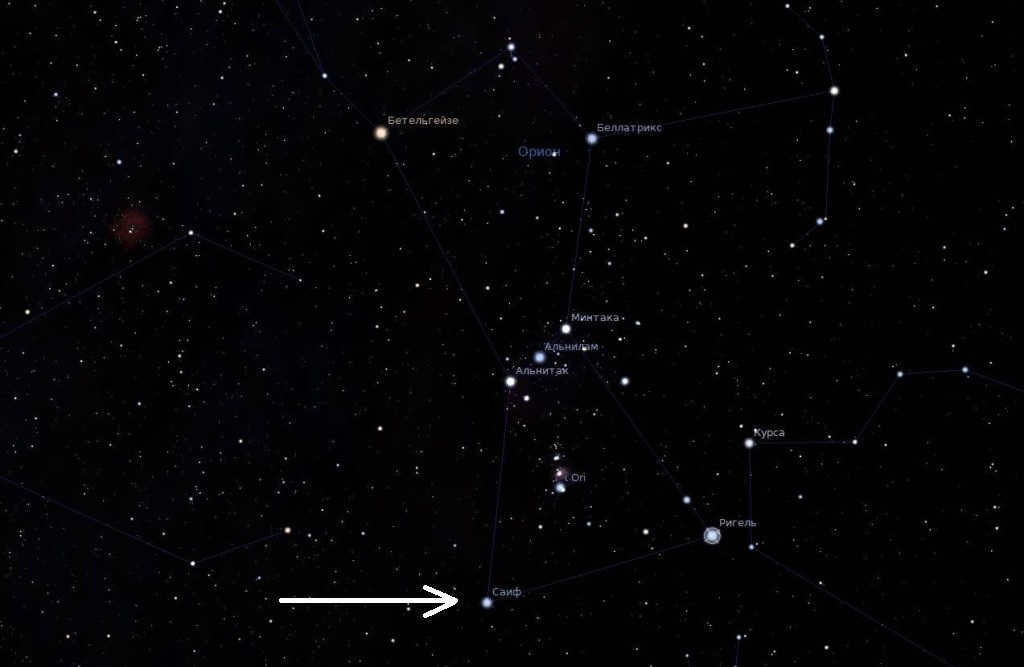
Bright Sword.
The name “Nair al Saif” is Arabic and translates to “bright sword.” It is a massive blue star that shines brightly in the sky. Nair al Saif is the most prominent star in the Sword of Orion constellation and can be found at the very end of the constellation. It has an apparent magnitude of approximately +2.75 and is located at a distance of 1325.9 light years from Earth.
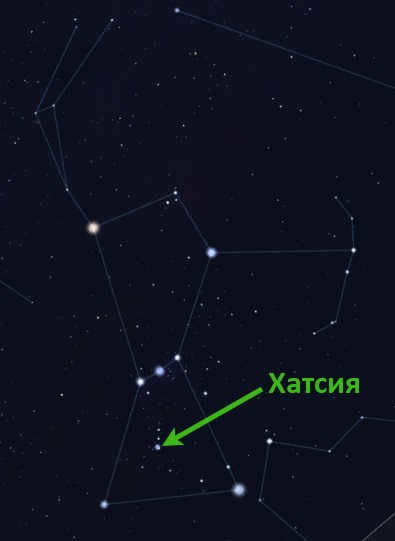
Orion’s Lambda Star
Meiss, also known as Orion’s Lambda, is commonly referred to as “shining.” With an approximate apparent magnitude of +3.33, this celestial system is situated at a distance of 1,100 light years from Earth. It can be found on the “head” of the Orion constellation and is surrounded by a massive nebula. While Lambda can be observed with binoculars or a small telescope, its nebula is only visible in photographs. The Orion’s Lambda system is divided into two components, A and B. Meissa is relatively easy to locate, positioned above Orion, which has an hourglass-like shape. Lambda forms a triangle with the prominent stars Betelgeuse and Bellatrix.
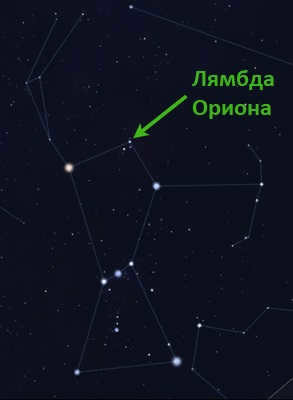
Lambda Orion A is composed of a blue giant classified as O8 III. It is 27.9 times larger and 165,000 times brighter than our Sun. The majority of its energy is emitted in the ultraviolet spectrum, which is invisible to the naked eye. This star also emits X-rays, suggesting the presence of a stellar wind. Similar to other massive stars, it will eventually undergo a supernova event.
Lambda B in the Orion constellation is categorized as a B0.5 V main-sequence star. It has a slightly lower apparent brightness, with a visual magnitude of +5.61. Additionally, Lambda B is 10 times more massive than our Sun.
Orion’s Phi
Located on the outskirts of the Orion constellation, there is a fascinating system known as Orion’s Phi. This celestial wonder can be found in close proximity to the southern part of Orion’s Lambda. The primary star of this system is Phi 1, a colossal class B (B0) giant. Situated at a distance of 1,087 light-years from the Sun, Phi 1 is a spectacular double star with an apparent magnitude of +4.42. It boasts a mass that is 15 times greater than our Sun and is a proud member of the Lambda Orion stellar association, also known as Collinder 69.
The second star in this captivating system is Phi 2, a subgiant belonging to the G8 III-IV class. Phi 2 has a mass that is 1.07 times that of our Sun and shines an impressive 31.6 times brighter. Its temperature is approximately 4856 K, adding to the allure of this celestial duo.
Orion’s Pi
The Orion’s Pi is a collection of stars found within the Orion constellation, serving as its protective shield. Unlike binary and multiple star systems, the stars within this group are widely separated from each other. It symbolizes the Shield and Luke asterism within Orion. Notable stars within this system include:
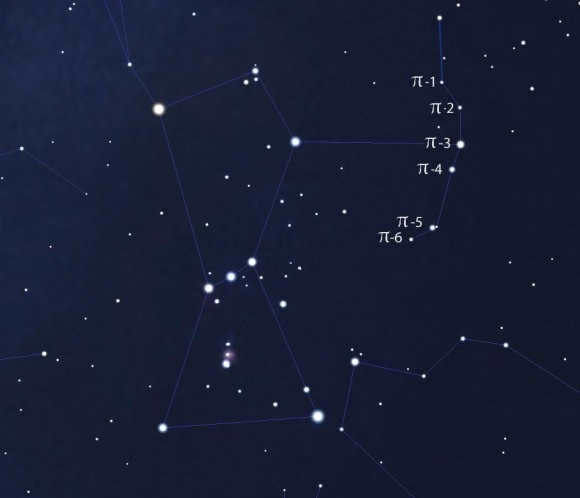

- Pi-1 Ori (also known as Pi 1 Orion);
- Pi-2 Ori (also referred to as Pi 2 Orion);
- Pi-3 Ori (often called Pi 3 Orion);
- Pi-4 Ori (commonly known as Pi 4 Orion);
- Pi-5 Ori (frequently referred to as Pi 5 Orion);
- Pi-6 Ori (also known as Pi 6 Orion).
π-1 has a magnitude of 4.74 and is relatively young, only 100 million years old. It is situated about 116 light years away from the Sun. This star is classified as a group A star, specifically an A3 Va. With a mass nearly twice that of the Sun, it shines 16.6 times brighter. The temperature of π-1 is 8611 K.
π-2 has an apparent magnitude of 4.35 and is located 224 light years away from the Sun. This star belongs to the A1 Vm type. It shines 70 times brighter than the Sun and has a temperature of 9457 K.
π-3 holds the title of the brightest star in the Orion Shield asterism. It is found at a distance of 26.32 light-years from the Sun.
π-4 has an apparent magnitude of 3.1 and is positioned 1050 light years away from the Sun.
π-5 has an estimated apparent magnitude of 3.69 and is situated at a distance of 1300 light years from the Sun.
π-6 is situated in its own separate area within the constellation’s eastern region. With an apparent magnitude of 4.469, it can be observed from a distance of 950 light years away. This star is categorized as an evolved giant within the K group, specifically classified as K0/1 III. Its luminosity is 2,200 times that of our sun, while its temperature measures at 4,217 K.
The system is located in the region between Orion Delta and Rigel, to the west of the Belt. It is situated within a distance of 1000 light years from Earth. This system is considered as part of the Orion's OB1 association. The primary star in this system, Eta Orion A, is notable for its multiple spectral lines that exhibit different radiant velocities. One of the more distant components in this system is Ac, which was discovered using the technique of speckle interferometry, in which several grainy images are analyzed to increase resolution. Ac is approximately 0.04 light-years away from the other stars in the system. The closest stars in this system, Aa and Ab, are separated from each other by a mere 0.01 light-years.
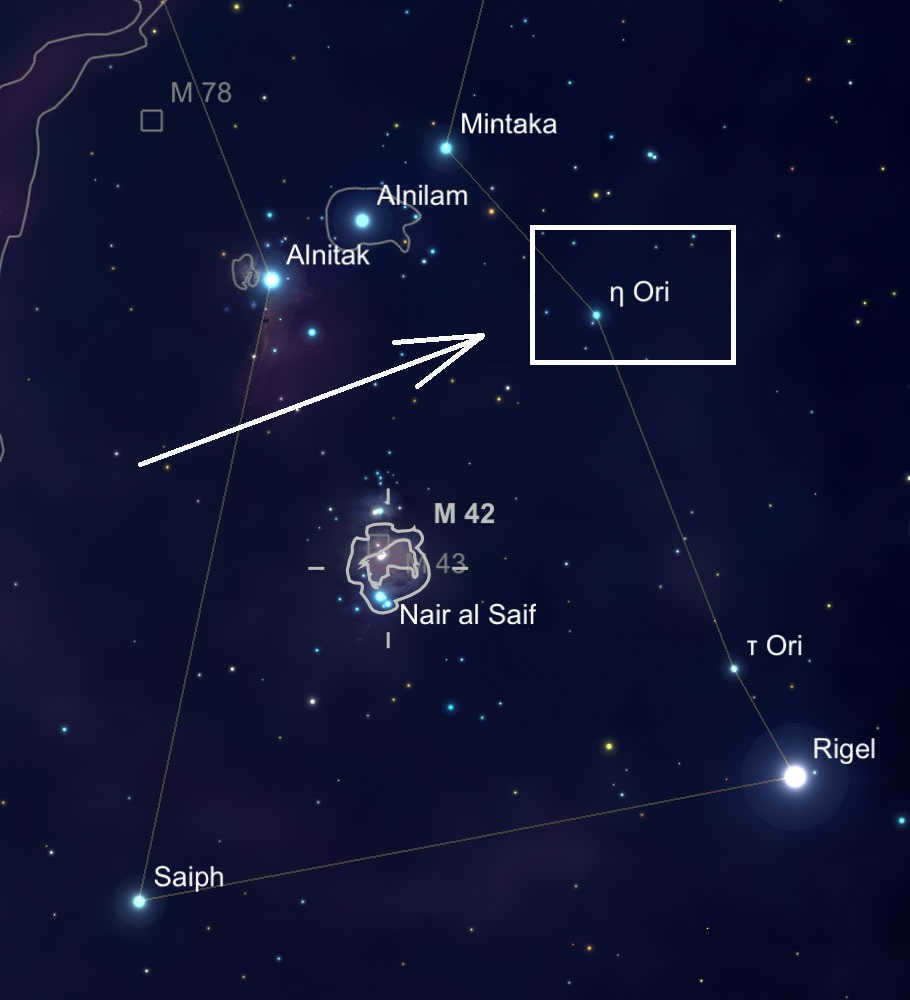

Sigma Orionis
Sigma Orionis is a star system that consists of several of the most prominent (in terms of apparent brightness), celestial and astronomical entities in the cluster. Situated to the southwest of Alnitak and to the west of the Horsehead Nebula (which it partially lights up), Sigma Ori is a captivating sight.
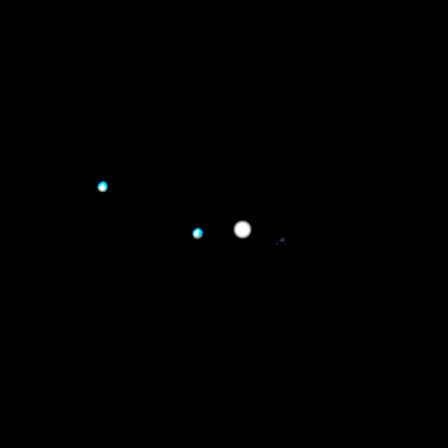

Sigma Orion forms part of the eastern section of the Belt. Its apparent magnitude is +3.80. Sigma Orion also includes:
- Aa – a star of class O9.5 with a temperature of 35000 K and a luminosity of 40000 L.
- Ab – a star of class B0.5 with a temperature of 31000 K and a luminosity of 18600 L.
- B – located outside the system but belonging to it. It is classified as group B0-2 and has a visible magnitude of 5.31.
- C is the faintest compared to the other stars in the Orion’s Sigma system. It has a visible magnitude of 14.07 and is likely to be classified as a brown dwarf. It belongs to the stellar group.
- D is a star of class B2 with a visual magnitude of 6.62. Its size, temperature, and luminosity are similar to Ori E.
- E is a unique star classified as an SX Aries variable. It is also called V1030 Orion. Its apparent magnitude ranges from approximately 6.61 to 6.77. The variations in its visual size are likely caused by its magnetic field, which ranges from -2,300 to +3,100 Gs. The increase or decrease of this magnetic field affects its brightness.
V380 Orion
V380 Orion is a trinary, or multiple system comprising of at minimum three stars. It is situated at the core of NGC 1999, an emission nebula. The pair of infrared sources within NGC 1999 are documented as satellites in certain catalogs, although they are not truly satellites. They have been assigned the names V380 Ori-B and V380 Ori-C.
The central star of NGC 1999, a hot white Herbig star Ae/Be of 10th magnitude, is considered to be the primary star. It has been designated with various spectral classifications, ranging from B9 to A1. Its surface temperature is approximately 15500±500 K. It is approximately 2.87 times more massive than the Sun and shines 100 times brighter. The star possesses a robust magnetic field that undergoes changes every 4.1 days. It is believed that this corresponds to the duration of its rotational period.
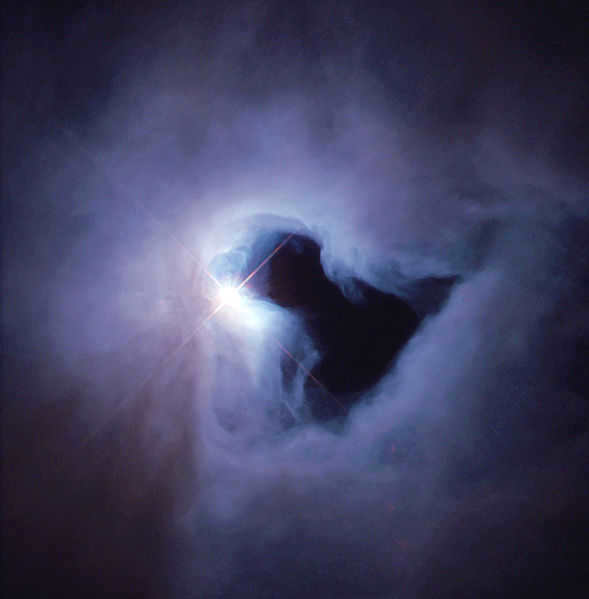
A secondary star, known as a T Taurus-type star, has been identified by its distinct spectral lines that are not found in the hotter primary star. It has a surface temperature of 5500±500 K. With a mass approximately 1.6 times that of the Sun, it is twice as large and three times brighter. The nature of the tertiary component in this system remains unknown, as no spectral lines have been observed from it. The fourth star in the system, V380 Orionis B, is located 0.06 light-years away from the other three stars. Based on its spectral class (M5 or M6), it is believed to be a red or brown dwarf.
It is believed that the system came into existence with all four stars in close proximity. However, as a result of interactions, the smallest star was ejected into an unstable orbit that is still held together by gravity, approximately 20,000 years ago. The primary and secondary stars are the closest to each other and complete one revolution every 104 days.
GJ 3379.
GJ 3379 is the nearest star to us in the Orion constellation, positioned 17 light-years away from our Sun as determined by parallax measurements. This star is an individual entity with a visible magnitude of +11.31 and an absolute magnitude of +12.71. Situated in the upper left region of the Orion constellation, GJ 3379 can be found south-southeast of Betelgeuse. It is moving away from our Sun at a radial velocity of 30 km/s. Approximately 161,000±6,000 years ago, GJ 3379 was situated at a distance of 4.08±0.20 light-years from our Sun.

GJ 3379 is classified as an M3.5V red dwarf, which is an M-type main-sequence star. It is significantly smaller, cooler, and less massive than our Sun, emitting only about 0.6% of its luminosity. This star is quite active, with its brightness fluctuating by an amplitude of 0.0074±0.0029 stellar magnitude. This variability is influenced by its rapid rotation period of 1.8 days. GJ 3379 also possesses a magnetic field strength of 2.3 kGs and emits X-ray radiation with a luminosity of 9.5*1027 erg/s. The SIMBAD database categorizes this star as an eruptive variable.
The stars within the constellation are slowly drifting apart. Nevertheless, due to their distance from our planet, the configuration remains distinguishable, whereas other constellations situated closer to Earth have undergone alterations in their forms over the course of time. It is only when Betelgeuse undergoes a supernova event in approximately one million years that the shape of Orion’s “shoulder” will be transformed into a faint point. Astronomer Kahler predicts that this occurrence will bring about tremendous disorder within the Orion constellation.
The constellation Orion is home to an extensive array of celestial objects in deep space, such as M42 (also known as NGC 1976), the Trapezium (which is a part of M42), M43 (or NGC 1982), and numerous others. For further information, visit the official website of NASA (https://www.nasa.gov), where you can explore a vast collection of high-resolution photographs showcasing various astronomical entities, including those mentioned in this particular article.
Orion Nebula or Messier 42 (M42, NGC 1976)
Situated at a distance of 1500 light-years, the Orion Nebula, also known as Messier 42 (M42, NGC 1976), holds the distinction of being the nearest major star-forming region to Earth. Its relatively bright apparent magnitude of 4, coupled with its prominent position just below Orion’s belt, allows it to be visible to the naked eye. For optimal viewing, it is recommended to observe M42 in the month of January.
The nebula contains four large, youthful stars at its vibrant core. These stars emit powerful ultraviolet light and radiation, which sculpt a hollow space within the nebula and hinder the growth of numerous smaller stars.
Orion’s Trapezium
The Trapezium is a group of four massive and cool stars located at the center of the Orion Nebula. These stars, which are situated in a region approximately 1.5 light-years square, are the most prominent and influential in the area. The Trapezium stars emit ultraviolet ionizing radiation, with the brightest star, Theta-1 Orion C, being the primary source. This radiation is responsible for fueling the visible luminosity of the entire star-forming region, creating a stunning spectacle.
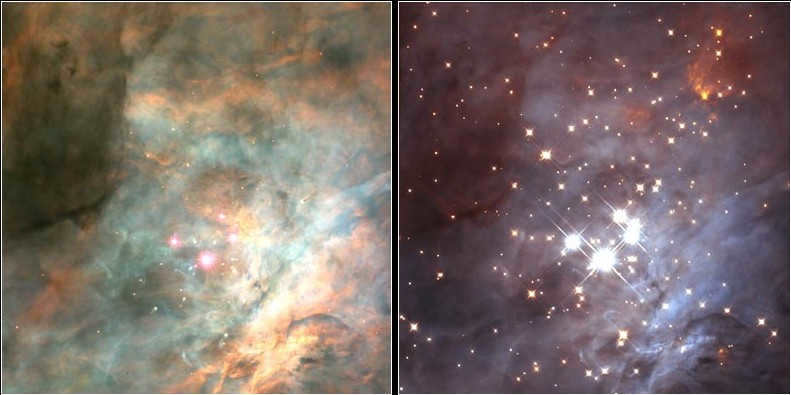
This nebula is approximately 3 million years old. When it was younger, it was even smaller. Recent studies have revealed an intriguing finding – as a result of uncontrolled stellar collisions, it is possible that a black hole with a mass over 100 times that of the Sun could have emerged at the center of the Trapezium at an earlier stage. The existence of such an entity in close proximity to the cluster’s center may account for the Trapezium stars’ elevated velocities.
De Meran or Messier Nebula 43 (M43, NGC 1982)
M43 forms part of a complex of molecular clouds. It is an often photographed but rarely mentioned companion of the more famous Messier 42. When viewed from Earth, some of the dust in the M43 nebula resembles a cascading waterfall. M43 itself is a region where stars are being born and, although it is filled with filaments of dark dust, it is primarily made up of luminous hydrogen. The entire area, which is located approximately 1500 light-years away, is full of intricate and picturesque dust filaments. Opaque to visible light, dark dust is formed in the outer atmosphere of massive, cold stars and is expelled by a powerful external wind consisting of protons and electrons.
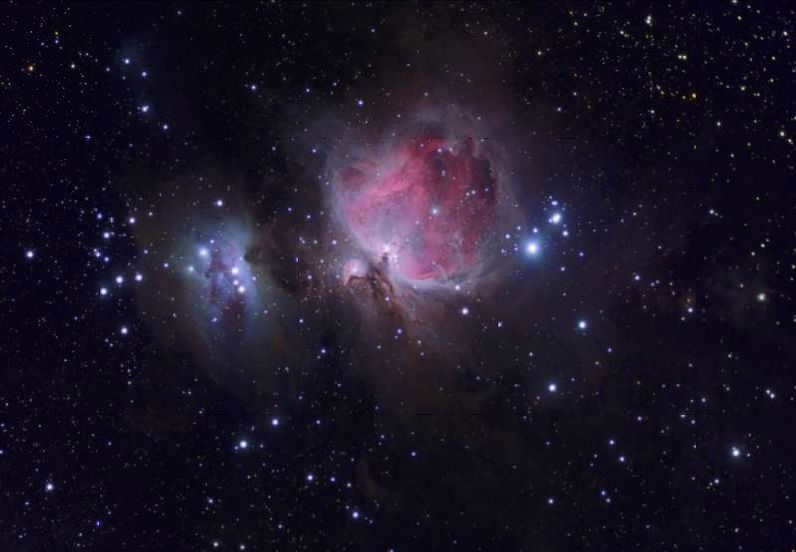
The Horsehead Nebula
Situated to the south of Alnitak, the Horsehead Nebula is a compact and shadowy nebula. It forms a segment of the larger Orion Cloud and can be found approximately 900 light-years away from our solar system.
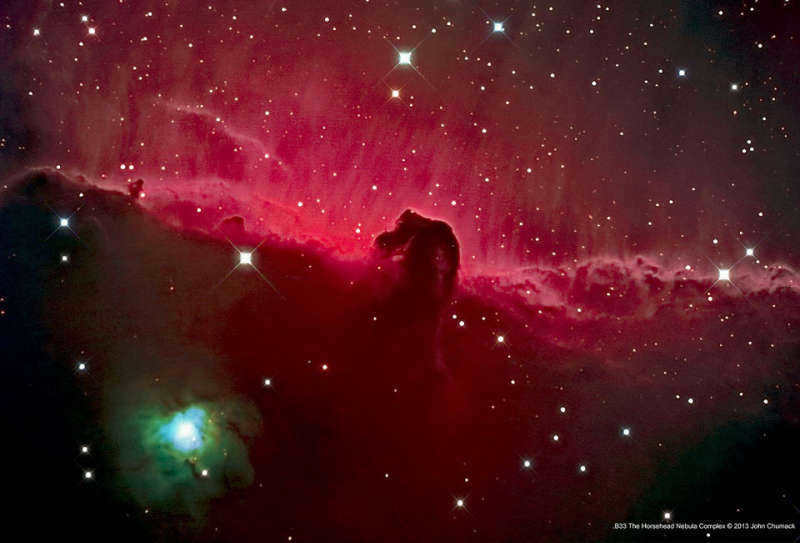
The Horsehead Nebula is characterized by its dark hue, which is caused by the high density of dust and gases that form its distinctive shapes. In the image, the nebula is enveloped in a vibrant red tone, attributed to the ionization of the hydrogens situated in its background.
An emission nebula known as the Flame Nebula is situated at a distance of 900-1500 light years from our Solar System. Its distinctive shape is the result of the influence of Alnitak, a nearby star that emits ultraviolet light. This radiation has the effect of displacing electrons from the nitrogen clouds, giving rise to the unique form of the Flame Nebula. At the heart of NGC 2024, the scientific name for the Flame Nebula, lies a young star cluster. This cluster is remarkable for its high concentration of stars and the presence of a circumstellar disk that covers 86% of the cluster’s area. The Chandra X-ray Observatory has identified approximately 800 stars within this cluster. The Flame Nebula, which is part of the larger Orion Cloud, is composed of interstellar matter.
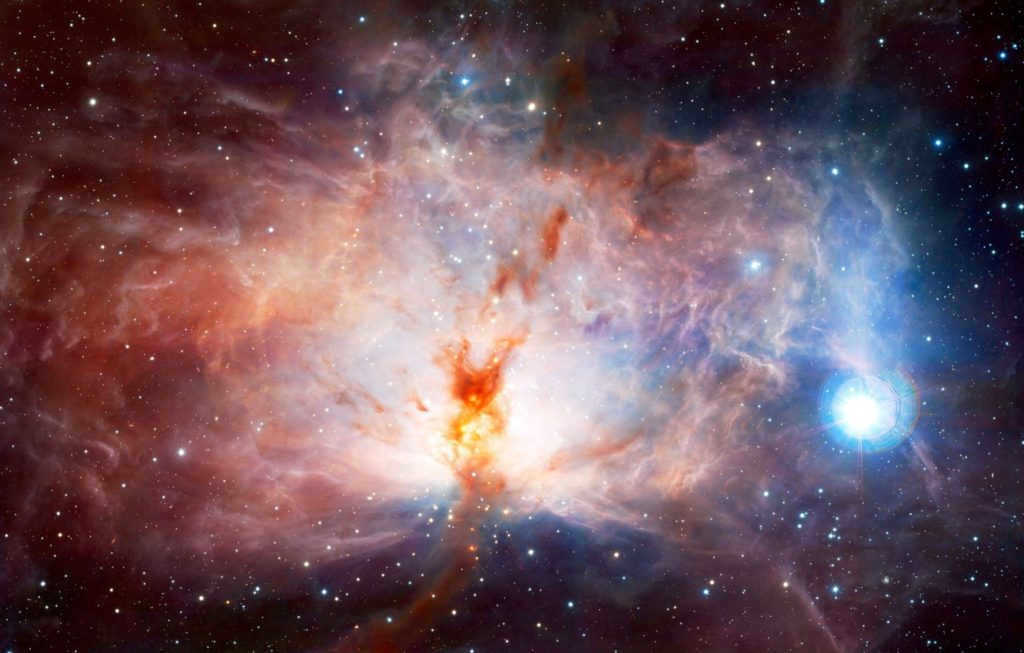
The misconceptions surrounding the constellation Orion
There are multiple legends surrounding the creation of this constellation. In one version, Orion was the son of a impoverished shepherd named Hyrias. One day, Zeus, Hermes, and Poseidon visited his humble home. Hyrias showed incredible hospitality by sacrificing his only bull to feed his guests, unaware that they were gods. In return, the gods granted him a wish, and Hyrias asked to have a child. The gods instructed him to bury the bull and wait nine months. After this time, a child emerged from the burial site, growing up to be a handsome and mighty man. The son of Hyrias became a skilled hunter and was employed by King Oenopion to rid the island of Chios of troublesome beasts. Upon completing his task, the hunter expressed his desire to eradicate all creatures on Earth. However, the goddess of the Earth, Gaia, disapproved of such a plan. She sent a colossal scorpion to confront the hunter. Realizing he could not defeat this monstrous creature with his strength and sword alone, Orion attempted to flee. Unfortunately, the scorpion managed to deliver a fatal sting. As a reminder to respect nature, Gaia immortalized the scorpion as a constellation in the sky, placing Orion in front of it. Thus, he is forever running from his fate, paying the price for his disregard for animals.





